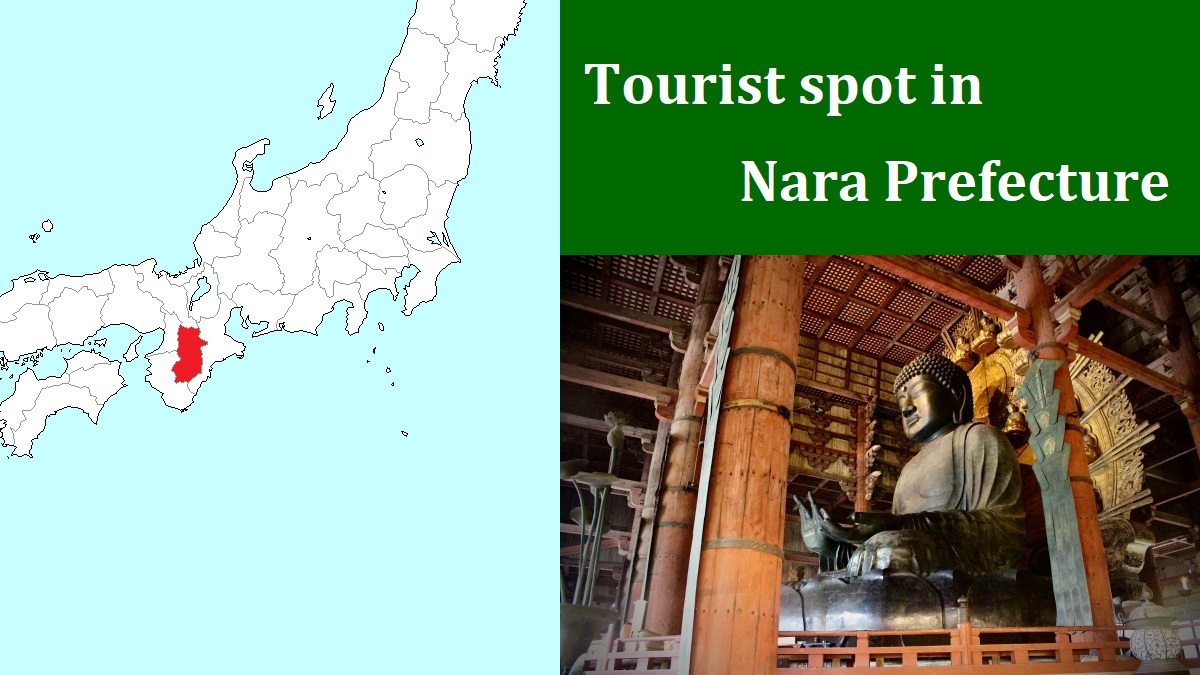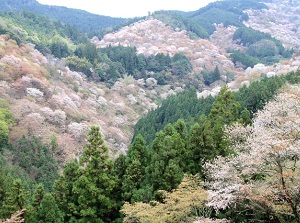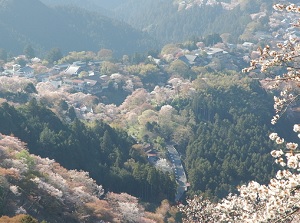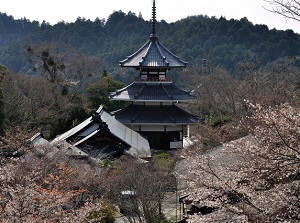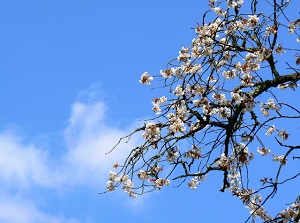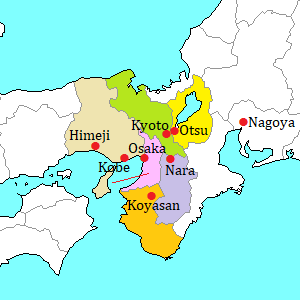Mount Yoshino [吉野山]
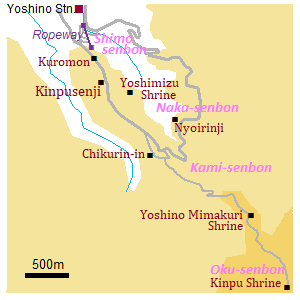
Mount Yoshino ("Yoshinoyama" in Japanese) is a mountain area located roughly in the center of Nara Prefecture.
It is located about 45 km south of Nara city, and is about 15 km south of Asuka village.
This area is often called Yoshino, simply.
Yoshinoyama is a part of "Sacred Sites and Pilgrimage Routes in the Kii Mountain Range" designated as a World Heritage Site.
Yoshino has been one of the sacred areas that the mountain worshippers has trained since the 7th century.
And a mountain path to make a pilgrimage with training leads from Yoshino to Three Grand Shrines of Kumano.
It is one of the ancient pilgrimage routes to there, and is the hardest route of them. The length is about 140 km.
The main area of Yoshino is located at 250 to 850 meters above sea level.
The lowest point is the entrance of Yoshino, and there is the terminal station of Yoshino Line of Kintetsu Railway.
The area spreads along valleys and ridges of the mountains for about 8 km.
And some temples and shrines are dotted in this area.
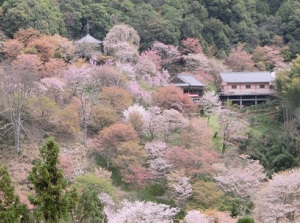
Sakura around Nyoirinji
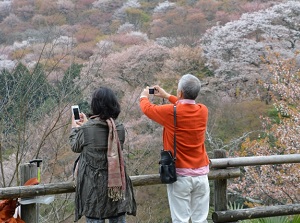
Observatory in Yoshino
After all, the attractive feature of Yoshino is Sakura (cherry blossoms).
There are about 30,000 cherry trees in the area of Yoshino.
There are four districts with many cherry trees in this area.
From the lowest district to the highest district, they are Shimo-senbon (下千本, around an altitude of 250 meters), Naka-senbon (中千本, 400 meters), Kami-senbon (上千本, 600 meters) and Oku-senbon (奥千本, 800 meters).
"Senbon" means "a thousand trees".
But, we can see some thousands of cherry trees at one view in each district.
Of course, the season is in April.
Each district is at the a different altitude.
So the period in full bloom is also different at each district.
The lowest Shimo-senbon is in full bloom around the early April, and the highest Oku-senbon is in full bloom in the late April.
So we can enjoy the cherry blossoms in Mount Yoshino for the whole month of April.
By the way, most of the cherry trees in Yoshino are "Yamazakura".
It is one of the species of wild cherry.
Popular cherry trees we can see in most places in Japan are called "Somei-Yoshino", and it was produced through crossing a few wild cherries in the 18th century.
Because Yoshino had been famous for the cherry blossoms since the ancient times, the name was used for the new species.
To Yoshino, it is convenient to use Yoshino Line of Kintetsu Railway.
The terminal station is Yoshino, and a ropeway is operated from there.
The ropeway climbs the difference of about 100 meters in height.
The district around the terminal of the ropeway is Shimo-senbon.
From here, route buses are operated to the other districts.
When you tour around Yoshino area, you had better plan to transport with using both the route bus and walking.
Because the area is hilly and the road is not wide, the route bus is a microbus with about 20 seats.
In addition, it usually runs once an hour, and runs four times an hour even during the season of cherry blossoms.
So, the bus is often filled with passengers.
Kinpusenji temple (金峯山寺)
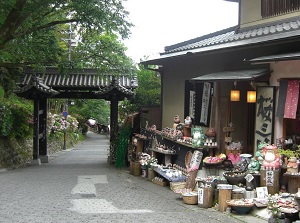
Kuromon on the road to Kinpusenji
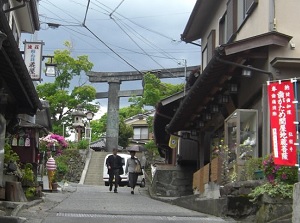
Kane-no-Torii near Kinpusenji

Kinpusenji is a Buddhist temple for mountain worshippers and was founded in the late 7th century.
It is the principal temple in Yoshino, and is in Naka-senbon.
The main precinct is located about 500 meters from the station of ropeway.
On the way to there, Kuromon gate (黒門) is on the road.
It is the main gate of Kinpusenji and was rebuilt in 1985.
And, there is Kane-no-Torii gate (銅の鳥居) near the main precinct.
It is one of the four gates to the sacred mountain.
The original gate was created with leftover copper after Daibutsu (Great Buddha) of Todaiji was constructed in the middle of 8th century.
Current gate was restored around the 1450s after destruction by fire.
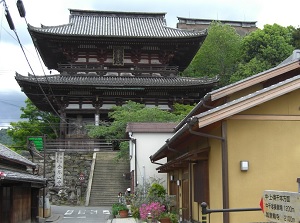
Niomon of Kinpusenji
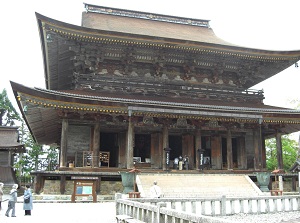
Zaoudo of Kinpusenji
The big gate to the main precinct is Niomon gate (仁王門).
It was rebuilt in 1456 and the height is about 20 meters.
It is desingnated as a national treasure.
The huge main temple is called Zaoudo (蔵王堂).
It was rebuilt in 1592 and the height is about 34 meters.
It is also desingnated as a national treasure.
Yoshimizu Shrine (吉水神社)
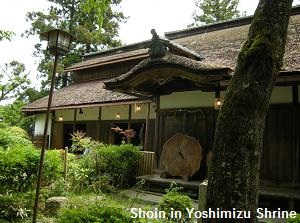
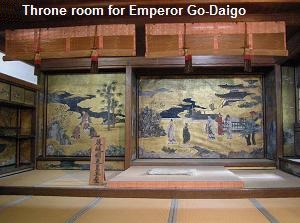
Yoshimizu Shrine is a Shinto shrine, and is located about 0.5 km southeast of Kinpusenji temple.
The shrine was founded in the middle of 7th century as a Buddhist temple.
But, it was changed to Shinto shrine in 1875.
Emperor Go-Daigo (1288-1339) lived there for the last several years of his life after he was expelled from Kyoto because of political change.
And Toyotomi Hideyoshi (1537-1598), the warlord who unified Japan, stayed here to see cherry blossoms.
Therefore, the buildings had been constructed like a palace.
Especially, Shoin (書院) is registered as a World Heritage Site, as the oldest Shoin building in Japan.
It has the room for Emperor Go-Daigo, and many articles about them are displayed.
And, we can see the view of both Naka-senbon and Kami-senbon from this shrine.
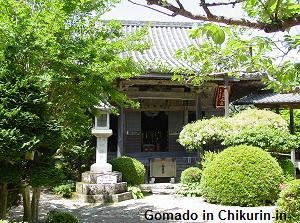
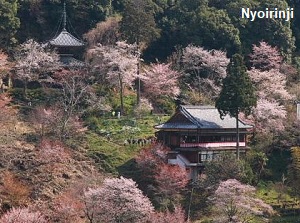
Chikurin-in temple (竹林院)
Chikurin-in is a Buddhist temple.
It is located about 1 km south-southeast of Kinpusenji, and is in Kami-senbon.
It is said that it was founded by Prince Shotoku in the early the 7th century.
The main temple is "Gomado", and there is a beautiful Japanese gareden "Gunpoen" behind Gomado.
This temple has an inn (Shukubo), and we can stay here.
Nyoirinji temple (如意輪寺)
Nyoirinji is a temple of Jodo-shu (Pure Land Buddhism).
It is located about 0.7 km northeast of Chikurin-in as the crow flies.
Because it is on the mountainside across a valley from Chikurin-in, the distance of the road is about 1.4 km.
It was founded in the early 10th century, and was reestablished in 1650.
The temple is in Naka-senbon, there are some buildings such as main temple and Tahoutou pagoda in the precinct.
And there is the tomb of Emperor Go-Daigo near the temple
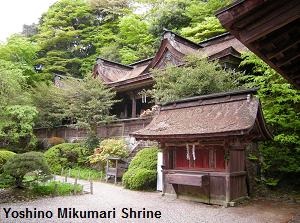
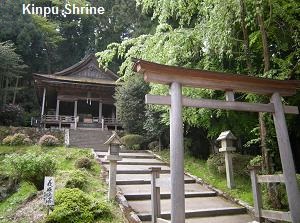

Yoshino Mikumari Shrine (吉野水分神社)
Yoshino Mikumari Shrine is a Shinto shrine.
It is located about 1.5 km southeast of Chukurin-in and is in Kami-senbon.
It is said that it existed in the late 7th century.
Current main shrine was built in 1605.
It is believed that couples who pray for this shrine will be blessed with children.
Kinpu Shrine (金峯神社)
Kinpu Shrine is a Shinto shrine.
The shrine is located about 2 km southeast of Yoshino Mikumari Shrine.
It is in Oku-senbon, and is in the most remote part of Yoshino area.
It is about 5 km away from Kinpusenji.
It is unknown when this shrine was founded.
In this shrine, a god living in Yoshino has been shrined.
How to get here
By Yoshino Line of Kintetsu Railway, get off at Yoshino terminal station.
About 1.5 hours from Osaka-Abenobashi (neat Tennoji) by limited express, about 55 minutes from Kashihara-jingu-mae (Transfer station from Nara, Kyoto).

